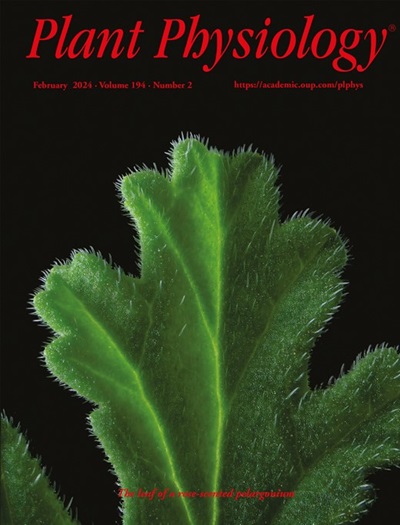Exclusive and hypersensitive stomatal control by blue-light in Equisetum
IF 6.9
1区 生物学
Q1 PLANT SCIENCES
引用次数: 0
Abstract
Most ferns are adapted to lower-light environments and have relatively low rates of leaf gas exchange compared to seed plants. Recent studies suggest that certain fern groups adapted to full-sun, yet ever-wet, environments have evolved novel stomatal regulatory mechanisms, particularly in response to light, enabling higher rates of leaf gas exchange. Among these lineages, the genus Equisetum, a morphologically and ecologically distinctive group of ferns, remains poorly understood in terms of stomatal physiology. Here, we investigated stomatal control by light in Equisetum by combining observations of stomatal conductance in the field with measurements of canopy conductance in a controlled environment and stem-level gas exchange responses to varying wavelengths and intensities of light. We found that Equisetum stomatal closure in the dark occurs over five minutes, which is extremely fast compared to other ferns. Additionally, Equisetum has lost a stomatal response to red light, with stomata exclusively regulated by blue light. This novel regulation of stomata by blue light and rapid stomatal closure in the dark results in strong co-ordination between canopy conductance and light intensity at the end of the day. Our results have implications for understanding the regulation of stomata by light and suggest that there is considerable ecologically relevant diversity in stomatal regulation within ferns.蓝光对木贼草气孔的排他性和超敏性控制
大多数蕨类植物适应弱光环境,与种子植物相比,叶片气体交换率相对较低。最近的研究表明,某些蕨类植物适应了充足的阳光,但一直潮湿的环境,已经进化出了新的气孔调节机制,特别是对光的反应,使叶片气体交换率更高。在这些谱系中,鼠尾草属是蕨类植物中形态学和生态学上独特的一类,但在气孔生理学方面仍然知之甚少。本研究通过结合野外气孔导度观测和受控环境下冠层导度测量以及不同波长和强度光下茎级气体交换响应,研究了光对木贼草气孔的控制作用。我们发现,在黑暗中,木贼的气孔关闭时间超过5分钟,与其他蕨类植物相比,这是非常快的。此外,木贼草失去了对红光的气孔响应,气孔只受蓝光调节。这种蓝光对气孔的新调节和黑暗中气孔的快速关闭导致了一天结束时冠层导度和光强之间的强烈协调。我们的研究结果对理解气孔受光的调节具有重要意义,并表明蕨类植物的气孔调节存在相当大的生态相关多样性。
本文章由计算机程序翻译,如有差异,请以英文原文为准。
求助全文
约1分钟内获得全文
求助全文
来源期刊

Plant Physiology
生物-植物科学
CiteScore
12.20
自引率
5.40%
发文量
535
审稿时长
2.3 months
期刊介绍:
Plant Physiology® is a distinguished and highly respected journal with a rich history dating back to its establishment in 1926. It stands as a leading international publication in the field of plant biology, covering a comprehensive range of topics from the molecular and structural aspects of plant life to systems biology and ecophysiology. Recognized as the most highly cited journal in plant sciences, Plant Physiology® is a testament to its commitment to excellence and the dissemination of groundbreaking research.
As the official publication of the American Society of Plant Biologists, Plant Physiology® upholds rigorous peer-review standards, ensuring that the scientific community receives the highest quality research. The journal releases 12 issues annually, providing a steady stream of new findings and insights to its readership.
 求助内容:
求助内容: 应助结果提醒方式:
应助结果提醒方式:


